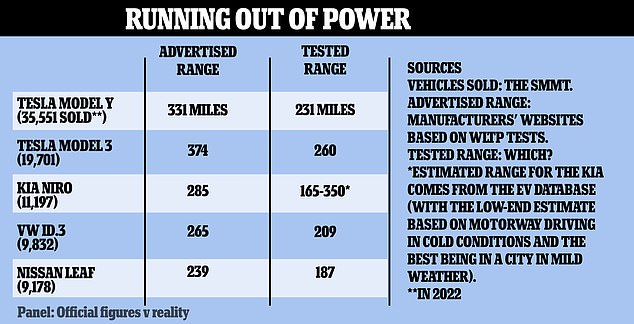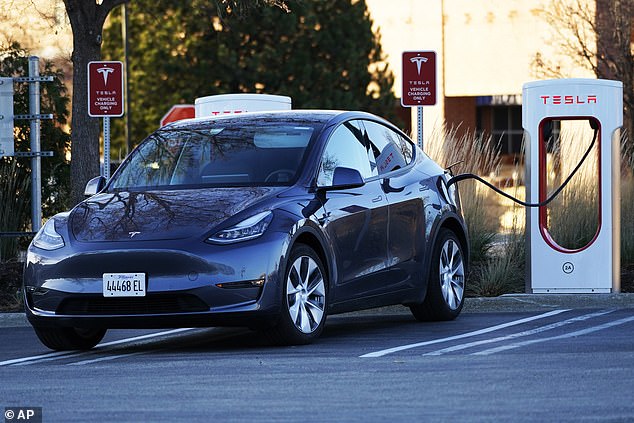
Manufacturers of electric cars are using exaggerated driving ranges as the official tests to not reflect real life, a study has revealed.
More than 70 electric vehicles were analysed in independent tests by consumer champions Which? showed that real-world ranges were almost 20 per cent lower than what car makers advertised, on average.
Tests also found that electric car batteries will need around 15 per cent extra power than what has been advertised to fully charge – resulting in higher running costs.
The UK’s most popular EV the Tesla Model Y, reportedly had a real-world range of 100 miles fewer than what was advertised, and the Nissan Leaf lost more than 50 miles compared to what was promoted.
Drivers debating whether or not to buy an electric car should be ‘sceptical’ of the advertised range and ensure they do ‘rigorous’ research before making an expensive purchase, Which? said.

Table showing the difference between advertised ranges of electric vehicles vs tested ranages




Britain’s most popular electric car, the Tesla Model Y (pictured), has one of the most disparate differences between its advertised range, 331 miles, compared to its real-world range of just 231 miles, 100 miles less, according to Which?
This came as the government this week announced that more than a fifth of new car sales next year are of electric cars – with a ban on new petrol and diesel cars to be introduced in 2030. Currently, around one sixth of new car sales are electric.
The result could leave electric vehicle drivers ‘disappointed by the distance they can realistically cover on a single charge,’ Which? sustainability editor Emily Seymour said, The Times reports.
Electric car makers have used a lab test called the Worldwide Harmonised Light Vehicle Test Procedure (WLTP) to determine ranges since 2017, under EU law. This was brought in after the previous testing regime was accused of overstating the fuel efficiency of fossil-fuel powered cars.
The WLTP give more accurate results for petrol and diesel cars but as a ‘strong tendency’ to overstate the efficiency and range of EVs, Which? claim. And they say that their own tests provide a more realistic estimate.
EVs often have shorter ranges on dual carriageways and motorways as they use more power to drive at higher speeds – and also reclaim less power from braking.
According to Which? bigger electric vehicles had the worst real-life range compared to what was advertised – averaging more than 50 miles less. This could mean drivers on long journeys could be left significantly out of pocket if they need to charge during a journey within the advertised range, that they cannot complete, due to the higher cost of service-station chargers compared to domestic ones.
Britain’s most popular electric car, the Tesla Model Y, has one of the most disparate differences between its advertised range, 331 miles, compared to its real-world range of just 231 miles, 100 miles less, according to Which?
The Nissan Leaf is advertised as reaching a range of ‘up to 239 miles’ – although the manufacturer says this ‘does not refer to a particular individual vehicle’. Which? research found a maximum range of just 187 miles.
James Court, of the Electric Vehicle Association, told The Times that there were large cars that are more efficient but some that lose range in colder conditions.






The Nissan Leaf (pictured) is advertised as reaching a range of ‘up to 239 miles’ but Which? research found a maximum range of just 187 miles
Nissan told the paper: ‘WLTP testing is mandatory and the only universal range figure quoted by all manufacturers. It is used by consumers to compare the range of different models. We have a real-world range calculator easily available on our website where customers can adjust parameters to view accurate and realistic range figures based on their individual circumstances.’
Tesla did not give a comment to The Times but have previously dismissed independent testing, saying that fair comparisons can only be made under lab conditions.
Mike Hawes, of the Society of Motor Manufacturers and Traders, told the paper: ‘By law, manufacturers are required to test all vehicles to the same, repeatable official standard — the WLTP Test. This test is regulated by government authorities and it is these results — and only these results — that manufacturers are required by law to publish. There will, however, always be a difference between lab tests and real-world use. Battery range, for instance, like fuel economy on petrol and diesel vehicles, will vary depending on the type of journey made, the conditions, driving style, vehicle load and other factors.’
Source: | This article originally belongs to Dailymail.co.uk